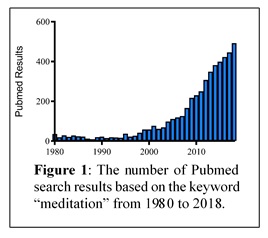“Kidneys…relax…” I know where my kidneys are located thanks to my anatomy classes, but how would I make them relax, and do I even want them to relax? They fulfill a pretty crucial physiological role. These and many other thoughts came to mind as I sat during a guided, progressive relaxation mediation organized by medical student Vignesh Sadras. Another question that came to mind was “how did I get here?” Most graduate students will ask themselves this question at some point during their thesis research. Fortunately, in this case I had an easy answer: I had joined the University Health Services (UHS) Wellness listserv.
UHS provides medical, mental health and wellness services to students, residents, fellows and trainees on the Johns Hopkins East Baltimore campus. Their staff includes internal medicine physicians, psychiatrists, a licensed psychologist, nurse practitioners (including a women’s health nurse practitioner) and licensed clinical social workers. In addition to these clinical aspects, a branch of the UHS that is a particularly great resource is UHS Wellness.
This office is under the direction of Patti Truant Anderson, and their mission is to enrich the experience of Johns Hopkins’ staff and students, help them thrive professionally and personally, and promote an environment that supports their health and well-being. UHS Wellness focuses on six broad areas of wellness: physical, mental/emotional, environmental/institutional, financial, interpersonal and intellectual wellness. This office is constantly striving to meet the diverse needs of the Johns Hopkins community, and one of the new programs they have helped promote this summer is the weekly meditation series organized by second-year medical student Vignesh Sadras.
Vignesh was inspired to start this series by his friend Sirtaj Singh. The two met during their undergraduate education at Johns Hopkins, and both were active at the Interfaith Center on campus. Sirtaj had a passion for learning about religion and enjoyed teaching what he knew to those around him. He went on to get his Master of Health Science at the Bloomberg School of Public Health, and started a weekly meditation series at the school.
Vignesh told me one story in particular that showed how passionate Sirtaj was about sharing his knowledge of meditation and building an open, welcoming community. There was an instance when he had to find a new time for his weekly series, and he realized it was impossible to find a single time that worked for everyone. Sirtaj’s solution was to start leading two weekly sessions to ensure the group was open to as many people as possible.
After completing his first year of medical school, Vignesh decided it was his turn to pick up the torch and run with it. His goals for this new series are to build a community, to learn and teach about different meditation techniques, and to help himself build a regular practice.
These meditation sessions consist of a five-minute introduction to a meditation technique from one of the Dharmic religious traditions (Buddhism, Hinduism, Jainism and Sikhism), 15–20 minutes of guided, silent meditation, and a short discussion afterward. After one guided meditation session, our discussion ranged from practical questions like “My foot fell asleep. What should I do about it?” to challenging philosophical questions like “What is awareness?”
One thing I have learned from Vignesh’s meditation sessions is that my simple concept of what meditation entails — sitting silently, focusing on the breath and trying to empty my mind — barely scratches the surface. There are a variety of different meditation techniques, and his series provides a platform to explore them and discover what works best for you.
 A popular form of meditation is mindfulness meditation. This technique has its roots in Buddhist meditation traditions, and practices nonjudgmental attention to experiences in the present moment. Research has shown that mindfulness meditation programs can moderately improve anxiety, depression and pain. While this field of research is still in its early days, the number of scientific studies exploring the physical and mental benefits of meditation has grown enormously in the past two decades (Figure 1). This publication trend is unsurprising as there are more people practicing meditation in America than ever before. A complementary health questionnaire developed by the National Institutes of Health and the Centers for Disease Control and Prevention’s National Center for Health Statistics showed that the use of meditation by U.S. adults increased more than threefold, from 4.1% in 2012 to 14.2% in 2017.
A popular form of meditation is mindfulness meditation. This technique has its roots in Buddhist meditation traditions, and practices nonjudgmental attention to experiences in the present moment. Research has shown that mindfulness meditation programs can moderately improve anxiety, depression and pain. While this field of research is still in its early days, the number of scientific studies exploring the physical and mental benefits of meditation has grown enormously in the past two decades (Figure 1). This publication trend is unsurprising as there are more people practicing meditation in America than ever before. A complementary health questionnaire developed by the National Institutes of Health and the Centers for Disease Control and Prevention’s National Center for Health Statistics showed that the use of meditation by U.S. adults increased more than threefold, from 4.1% in 2012 to 14.2% in 2017.
Putting aside the medical benefits and popularity of meditation, there is one additional aspect of Vignesh’s meditation series that I greatly appreciate. It is unique to have an activity on campus that truly brings together different parts of the JHMI community. One element of Johns Hopkins Medicine’s strategic plan for 2019–2023 is to “Work Like One Organization.” Too frequently, we only interact with people in our own departments, but Vignesh’s meditation sessions bring together graduate and medical students as well as postdocs and principal investigators. I hope you will consider joining us in practice to grow the community even more.
Related links
https://nccih.nih.gov/news/press/More-adults-and-children-are-using-yoga-and-meditation
https://www.nature.com/articles/nrn3916
Related content
- Improving Wellness for Health Care Providers
- The Many Benefits of Yoga
- Student Wellness Initiative Promotes Self-Care
Want to read more from the Johns Hopkins School of Medicine? Subscribe to the Biomedical Odyssey blog and receive new posts directly in your inbox.
